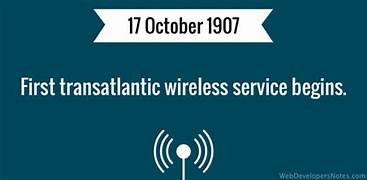On October 17, 1907, the United States witnessed a significant development in communication technology with the introduction of a new telegraph service. This event marked a milestone in the history of telecommunications and revolutionized the way information was transmitted across vast distances. The telegraph was not a new invention in 1907, but the introduction of a new telegraph service on this day represented a major advancement in the field. The telegraph had been in use since the mid-19th century, allowing messages to be sent electronically over long distances using Morse code. However, the new telegraph service brought improvements in speed, efficiency, and reliability. The telegraph played a crucial role in connecting people and businesses across the United States. It allowed for the rapid transmission of news, business transactions, and personal messages, bridging the gaps created by distance and time. Prior to the telegraph, communication relied heavily on physical mail, which could take days or even weeks to reach its destination. The new telegraph service introduced on October 17, 1907, brought several advancements to the field. It improved the infrastructure and reliability of telegraph lines, ensuring more efficient transmission of messages. The service also implemented new technologies and equipment that enhanced the speed and accuracy of the telegraph system. The telegraph service was particularly vital for businesses, allowing them to communicate and conduct transactions across great distances. It facilitated the growth of industries such as finance, manufacturing, and transportation, enabling companies to coordinate operations, negotiate deals, and stay informed about market conditions. The telegraph also had a significant impact on journalism and the dissemination of news. News agencies and newspapers relied on the telegraph to receive and transmit breaking news, allowing them to deliver timely information to their readers. This led to the rise of wire services, which collected and distributed news stories to subscribing newspapers across the country. The introduction of the new telegraph service on October 17, 1907, further expanded the reach and impact of this communication technology. It allowed for greater connectivity and efficiency in transmitting messages, reinforcing the telegraph's role as a vital tool in the modernization of communication. However, the telegraph's dominance would eventually be challenged by newer technologies, particularly the telephone and later, the internet. These technologies offered more immediate and interactive forms of communication, gradually rendering the telegraph obsolete. Nevertheless, the telegraph's impact on society cannot be overstated. It revolutionized the way information was transmitted, connecting people and businesses across vast distances and speeding up the pace of communication. It paved the way for subsequent advancements in telecommunications and laid the foundation for the global communication networks we rely on today. The introduction of the new telegraph service on October 17, 1907, represented a significant milestone in the evolution of communication technology. It brought improvements in speed, efficiency, and reliability to the telegraph system, enabling faster and more reliable transmission of messages. The telegraph's impact on business, journalism, and society as a whole cannot be overstated, and its legacy lives on in the modern communication systems that have followed.
17 Oct, 1907 U.S.A. Telegraph
